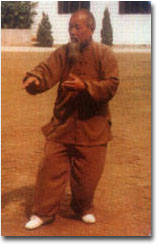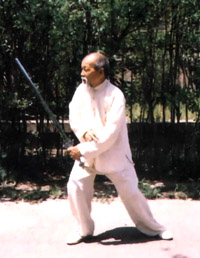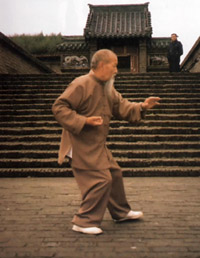The founders of Wu (Hao) style taijiquan are acknowledged to have authored some of the writings now considered as taiji classics. There are four main ‘branches’ of Wu (Hao) style in China, of which two are represented in the West. The four are (a) the taiji spread by the Hao family (as represented in the West by M Liu Jishun); (b) the taiji practiced by Hao Weizhen’s students from the Xingtai area in Hebei (as exemplified by Wu Wenhan and Chen Gu’an, whose student, Jimmy Wong, is spreading this version in the US); (c) the ‘old frame’ practiced by descendants of the Wu and Li families, and (d) the taiji spread to the Northeast of China (formerly called Manchuria) by Yan Zhigao, who I hope to profile in a later article.
In this article I’d like to introduce one of the most prominent practitioners of the ‘old frame’ in China, M Yao Jizu, who was from the ‘hometown’ of Yang and Wu (Yuxiang) styles of taijiquan, Guangfu town in Yongnian county, Hebei Province. Sadly, he passed away in 1998. His father, Yao Peiyu, had learnt Yang style taijiquan under Yang Luchan’s eldest son, Yang Fenghou. The following extract is from this article. M Yao can be seen performing his form here.
“In M Yao’s youth his family were wealthy. He first started to study martial arts from his father, Yao Peiyu. Later on, he became a disciple of Li Yiyu’s son Li Xunzhi, becoming M Li’s youngest disciple. Because he respected his master like a father, M Li was deeply fond of M Yao, they were very close. During the Cultural Revolution, M Yao suffered greatly: there were times where M Yao would be publicly denounced every day. What worried M Yao the most in this precarious situation was that his photographs of M Li would be confiscated, so he hid the photos underneath his vest. As hoped, the photos survived the cultural revolution, providing precious historical evidence for taiji historians. The photos of M Li Xunzhi that exist now are all copies of M Yao’s photos.
When discussing taiji with us, M Yao would frequently refer to M Li Xunzhi’s superb skills and kindness. His talks opened our eyes to the gratitude and respect that is owed a true teacher. He once said that there are 3 necessary requirements for someone to ‘make it’ in taiji: hard work, insight, and a teacher who understands the art. All 3 are indispensable, but the most important is to find a knowledgeable teacher, otherwise you could go a lifetime without an insight into what taiji is really about. Wu (Hao) style in practicular needs to be passed on in person for one to really plumb its depths. M Yao often said that he would not teach a loafer for any money, but would readily gift it to a friend.

M Yao practicing the form
M Yao obtained the real transmission of Wu (Hao) style and practiced hard. Every evening he would push hands at his home with his shixiong Wei Peilin. On a table nearby was food and wine. When tired they would have bite to eat and something to drink, rest for a while and then carry on pushing, right through the night until dawn the next day, only resting when M Wei went home to sleep. He spent decades investigating taiji, right until his passing, hence his skill was extremely pure.
In 1997, when M Yao (then aged 81) was staying at a disciple’s house, he would go to the adjacent Congtai Park to walk and teach taiji with his nephew Li Zhizhong, grandson-in-law Li Pingfang and his disciple Cui Zhiguang. One day, quite by chance he met his old friend Jia Pu (a grandstudent of Hao Weizhen through Zhang Zhenzong and Han Qinxian) in the park. M Jia asked M Yao to run through a routine. M Yao, not wanting to turn M Jia down, stood in the centre of the square, took a moment to settle himself, and then ran through the taiji form. While doing so, his joints emitted faint ‘pop’ noises and his footwork was incredibly light – no-one watching would have thought he was a pensioner over 80! By the end of it, he had attracted a crowd of dozens of onlookers including a bunch of M Jia’s students. After he had finished, they couldn’t resist clapping. M Jia said to one of the onlookers “Tong zi gong [gongfu acquired in childhood] is amazing, even in old age he hasn’t lost it!” On day that M Yao passed away, in the afternoon he was teaching and pushing with us disciples completely normally, and by the evening he had passed away peacefully. None of us disciples could believe it when we heard the news: M Yao really exemplified the motto ‘lifelong learning, practice and teaching’.
A METHODICAL AND INDEFATIGABLE TEACHER

M Yao practicing taiji sword
M Yao not only physically demonstrated what he meant, he often came up with unusual analogies and methods to make his students understand. He said that there shouldn’t be any ‘straight force’ in taiji, it should be all spirals and surging neijin. To illustrate, he took a hoop of string and looped one end around his neck and the other around his wrist. His neck and wrist pulled the string taut.
As soon as someone pushed on his arm, he could ‘launch’ them out without slackening the string [i.e. without retracting his arm]. He used this to show that taiji shouldn’t have straight force, nor ‘hollows and projections’ [ao tu], but rather that it uses the waist and legs to hit.
When explaining the principle of ‘bu diu bu ding‘ [don’t lose contact or resist], he said that it wasn’t just about not losing contact with the opponents, the amount of pressure had to be just right. To illustrate, he dragged a matchbox around a tabletop. He told us that if you used too much force [ding], the matchbox would be stuck to the table and wouldn’t move; if you used too little force [diu], your hand would slide off the matchbox and it still wouldn’t move. It is only if you use just the right amount of pressure that you can drag the box around as you please – the same applies to pushing hands. As well as being adept in the martial arts, M Yao was also well-educated. He could not only perform taiji beatifully, but also had his own unique insights into taiji principles. For example, in interpreting the principle of ‘my opponent doesn’t know me, I alone know him’ [ren bu zhi wo, wo du zhi ren], he emphasised that the hands should not wave about in pushing hands, because following and hitting the opponent is mostly in the waist and legs, the point of contact is merely a conduit for jin.
Thus, in pushing hands, he required his students to practice launching less and focus on practicing sticking and following [zhan nian lian sui]. When he pushed hands with us, he would often ‘lock up’ the force we gave him and we would have to follow him forwards, backwards, all the while not seeing his hands moving much. This is called ‘quan da bu zhi‘[hitting without the opponent knowing?]. He told us, if you can lock someone up with your shenfa, you can hit them at anytime, so we shouldn’t be too eager to launch people.
A Moral and Honest Elder

M Yao practicing form
M Yao was a calm, modest man. He didn’t talk about the failings of others, nor brag about his own abilities. In 1981 Miura Hideo, the director of the Japan Taichichuan Association, during a Japanese taijiquan delegation’s visit to China pushed hands with M Yao. M Yao raised his hands in front of his chest in a ‘peng’ posture. As soon as Miura pressed on M Yao’s arm, he was launched out by a motionless M Yao. Puzzled, Miura asked others to try, with the same result. Mr Miura exclaimed that Wu (Yuxiang) style taiji was really a treasure, and invited M Yao to visit Japan and offered to help him publish a book in Japan. M Yao politely declined the Japanese group’s offers and gifts. After they returned to Japan, they devoted many pages to introducing M Yao’s art in martial arts magazines.
Later on, they sent a valuable set of first day covers to M Yao as a token of respect. M Yao distributed them amongst the translators and workers at his workplace.
M Yao always received visitors warmly. In pushing hands he would only push until his partner was at a disadvantage, letting people leave convinced. One time, a famous taiji expert from Wuhan came to visit. Because he was a university professor and had achieved a certain fame, in pushing hands all M Yao did was stick and follow him. The professor, thinking that this was all there was to M Yao, said “This is covering and absorbing [fugai duitun], it can make it so you can’t move”. M Yao, seeing that the professor had an exaggerated estimation of his own abilities, said “Where do you think you are? Come and show off over here!” So saying, he advanced, planting his feet between the professor’s legs and launched him so that he flew back onto the kang*. Only then did the professor realise his mistake.”
*A kang is the name for the heated brick bed commonly found in houses in the north of China.
M Yao’s disciples, such as Zhai Weichuan and Zhong Zhenshan, continue to spread his taiji in China.May 10, 2009
Comments
Post a Comment